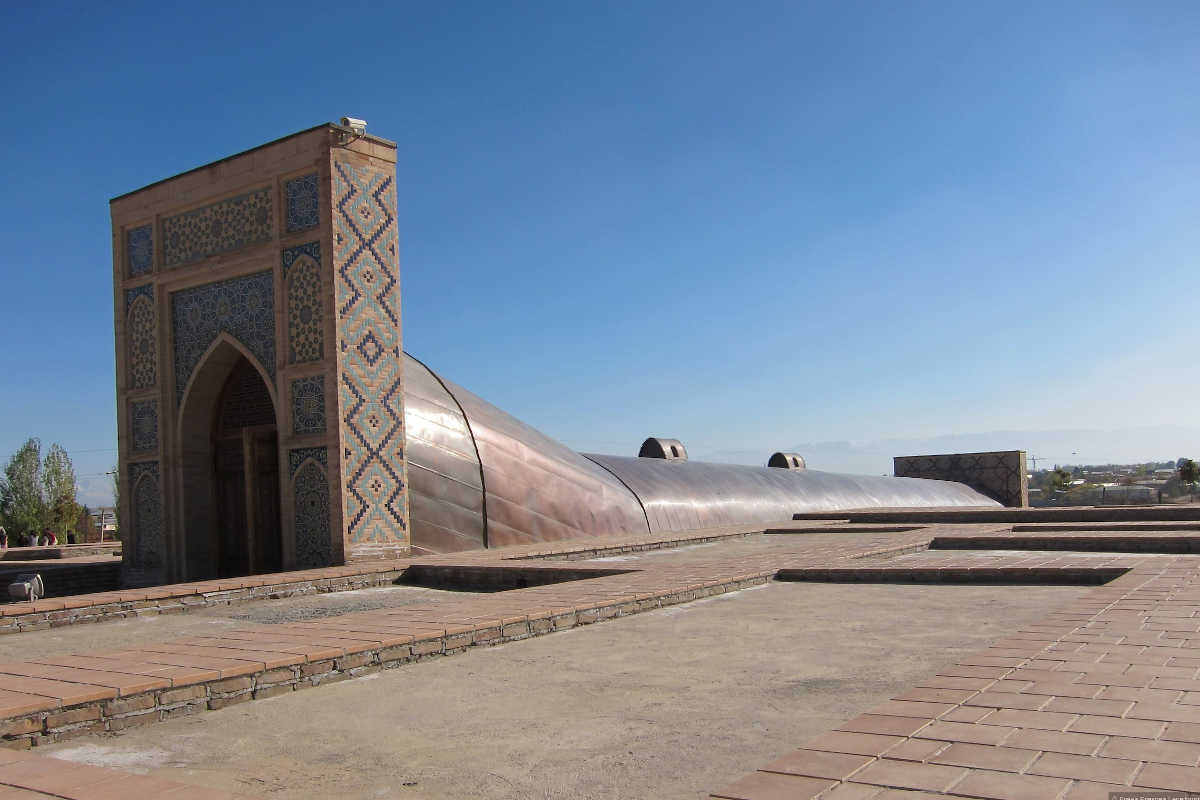Samarkand - Ulugbek Observatory
A suitable site for the construction of an observatory was selected in the north-east of Samarkand. Through the selection of famous astrologers a suitable lucky star was determined for Ulugbek Observatory in Samarkand.
The building was constructed as solidly as the foundation of power and the basis of greatness.

The presentation of the nine heavens and the image of the seven celestial circles with degrees, minutes, seconds and tenths of seconds, the celestial arc with the circles of the seven moving celestial bodies, the images of the moving stars, climatic zones, mountains, seas, deserts and everything connected with them were presented in the delightful drawings and depictions of the incomparable interior of the rooms of the elevated building.
This is what the historian Abd al-Razzaq wrote about this observatory in 1428-1429. The observatory was equipped with the best and most perfect instruments of the time.
It was a huge three-storey building, cylindrical in shape with a diameter of about 50 metres and a flat roof, which housed some astronomical instruments.
The plan of the building was quite complex: there were large halls, rooms, corridors, corridors connecting these rooms, etc. In the centre of the observatory was the main instrument – a magnificent marble sextant (possibly a quadrant) with a radius of 40.2 metres, mounted in the meridian plane.
Only the lower part of the instrument arch, divided into degrees, was preserved. The instrument is installed in a trench cut into the rock, about 2 metres wide and 11 metres deep. A part of it was lifted above the ground surface.
It consisted of two parallel stone arches lined with marble slabs of appropriate curvature. The Ulugbek Observatory determined the most important constant values in astronomy: ecliptic inclinations, equinoctial points, duration of the sidereal year and other values derived from observations of the Sun, the planets and the Moon.
Most probably Ulugbek made observations of stars with small armillary spheres, which have not been preserved. The huge size of the sextant, its successful construction and the unsurpassed skills of Samarkand astronomers ensured that the observations were highly accurate.
For example, the stellar year duration of Ulugbeg was determined in 365 days 6 hours 10 minutes 8 seconds. The actual value is 365 days 6 hours 9 minutes 6 seconds, i.e. Ulugbek was only mistaken by 62 seconds or 0.0002%!
The observatory’s most important work, the so-called New Astronomical Tables (Sidge and Jedi and Guragoni), contains a theoretical overview of astronomy and a catalogue of the positions of 1018 stars (published in Oxford in 1665).
Among Ulugbeg’s numerous observations, the table of geographical coordinates of 683 different settlements in the world is of great interest.
After the assassination of Ulugbek, the observatory, as the embodiment of his rule and enlightenment, was ruthlessly destroyed by religious fanatics. Already in the XVI century it was completely transformed into a heap of rubble. For a long time the exact location of the observatory remained unknown.
Only in 1908 Vyatkin managed to find its remains thanks to a document from the XVII century, which gave certain indications about the location of the observatory. During these excavations traces of a round wall in a brick and a part of the main tool were found.
No other astronomical instruments were found. In 1915 a vaulted ceiling was built over the excavated trench with part of the sextant to preserve the finds. The study of the observatory did not get a wide range until the Soviet period.
As a result of Sucharev’s excavations in 1941, and in particular the excavation of Shishkin in 1948, what was left of the once famous Arab observatory was opened to the public.
The poet Alisher Navoi wrote about Ulugbek
“All his conspecifics have been forgotten; who remembers them today?
But he, Ulugbeg, stretched out his hand to the sciences and achieved a lot”.
Next to the remains of the observatory there is a small museum with excerpts from the famous “Gurgan plates” – plates with information about the stars promoted by Ulugbek and his comrades-in-arms, engravings that testify to Ulugbek’s high authority among European scientists, a small collection of astronomical instruments where you can learn more about Ulugbek and the scientific methods he used.
